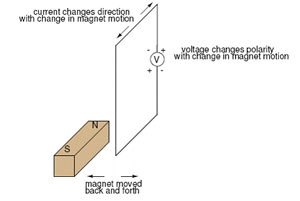Introduction to Electromagnetic Induction
 An easy way to create a magnetic field of changing intensity is to move a permanent magnet next to a wire or coil of wire.
An easy way to create a magnetic field of changing intensity is to move a permanent magnet next to a wire or coil of wire.
Remember: the magnetic field must increase or decrease in intensity perpendicular to the wire (so that the lines of flux "cut across" the conductor). Otherwise, no voltage will be induced.
Electromagnetic induction
Electromagnetic induction is produced by moving a magnetic field across a conductor. An emf is induced in a conductor when the magnetic flux linked with it changes. This process is used in the operation of generators, all electric motors, transformers, induction motors, synchronous motors, solenoids, and most other electrical machines.
When current passes through a wire it generates a magnetic field. Similarly, if a changing magnetic field passes through a coil, an emf appears in the coil. This phenomenon is called electromagnetic induction.
- There are two common ways to demonstrate electromagnetic induction:
(a) coil and magnet (as described above)
(b) coil and coil -- one of coils is connected to an ac supply, which generates a changing magnetic field in this coil, which then induces a current in the second coil.
- NOTE: The current depends on the fact that the magnetic field is changing.
Faraday’s laws of electromagnetic induction
There are two laws governing the phenomenon of electromagnetic induction. The first law gives the magnitude of the induced emf and the second law tells us the direction of the induced emf.
- Whenever the the number of magnetic lines of force that are linked with a closed circuit changes, an emf is induced in the circuit and will last so long as the change lasts. The magnitude of induced emf is equal to the rate of change of flux through the circuit. Thus
e = df/dt
Faraday named the current produced the ‘induced current’, the elf the ‘induced elf’, and the phenomenon ‘magnetic induction’.
- The second law, called Lenz’s law, states that the direction of induced emf is such that it opposes the change causing the induction
Induced emf = change in flux / time
e = (final flux – initial flux) / time
e = - dΦ / dt
The minus sign indicates the direction of the induced emf, and can be ignored in calculations of e.
Magnetic flux Φ
 Magnetic flux can be thought of as the total number of magnetic field lines passing through a particular area.
Magnetic flux can be thought of as the total number of magnetic field lines passing through a particular area.
Φ = BA
B = magnetic flux density, A = area
- Magnetic flux is a scalar quantity
- Unit = weber (Wb)
- Magnetic flux is 1 Weber if the magnetic
flux density over an area of 1m2 is 1T
Want to know more about electromagnetic induction? Click here to schedule a live session with an eAge eTutor!
About eAge Tutoring
eAgeTutor.com is the premium online tutoring provider. Using materials developed by highly qualified educators and leading content developers, a team of top-notch software experts, and a group of passionate educators, eAgeTutor works to ensure the success and satisfaction of all of its students.
Contact us today to learn more about our guaranteed results and discuss how we can help make the dreams of the student in your life come true!